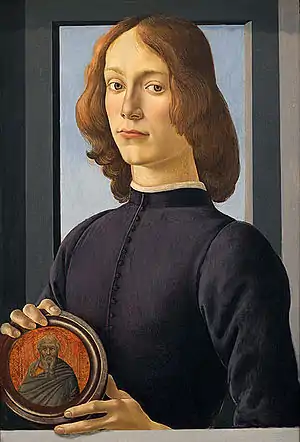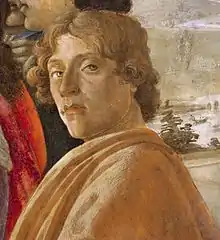Portrait of a Young Man Holding a Roundel
The Portrait of a Young Man Holding a Roundel is a painting attributed to Sandro Botticelli. Due to its style it has been estimated to have been painted around 1480.[1] The identity of the subject of the portrait is unknown, but analysts suggest it could be someone from the Medici family, as Lorenzo de' Medici was one of his main benefactors.[2] The painting is believed to represent the beauty ideals[3] of the Florentine high society during the Renaissance.[4] His tunic is of a simple, fine quality and its blue colour was very rare at the time.[5] The work was painted with tempera on poplar wood[6] and has the dimensions of 58.7 cm in height by 38.9 cm in width.[7] The figure of a saint in the roundel was added after the portrait was painted, and is believed to be an original of Bartolomeo Bulgarini.
| Portrait of a Young Man Holding a Roundel | |
|---|---|
 | |
| Artist | Sandro Botticelli |
| Year | c. 1480 |
| Medium | Tempera on poplar wood |
| Movement | Italian Renaissance |
| Owner | Private |
History
The first record of the painting was in 1938, when it was in the possession of Baron Newborough of Caernarvon.[7] At the time, the art dealer Frank Sabin[1] visited the Newborough estate and appraised the value of the painting.[7] As Lord Newborough did not know the true value of the painting, Sabin managed to buy the piece for a relatively small amount.[7] It is assumed by art historians that the painting came into the possession of the Newborough family when the 1st Baron Newborough, Thomas Winn, lived in Florence, Italy between 1782 and 1791.[1][7]
Frank Sabin sold the portrait to the collector Sir Thomas Merton in 1941 for a five-figure sum.[1] It is in his possession that the portrait was first described as a piece by Botticelli,[7] and his descendants sold it in 1982 through an auction at Christie's for £810,000.[1] During the time the Merton family owned the portrait, it became the subject of a poster for the Exhibition of Italian Art held by the Royal Academy of Arts in 1960.[8]
After Sheldon Solow bought the piece at auction in 1982,[9][1] the portrait was given on loan to major Museums including the Metropolitan Museum of Art in New York, United States, the National Gallery in London, England, and the Städel Museum in Frankfurt,[2] where it was displayed in a Botticelli exhibition in 2009–2010.[1] The attribution of the portrait to Sandro Botticelli has been disputed by various analysts in the past,[1][7] but currently this attribution is generally accepted by the majority of art historians.[1] In January 2021, the portrait was sold at an auction at Sotheby's in New York for more than US$92.2 million.[10]
References
- Thomas, Gina. "Mehr als 80 Millionen Dollar: Dieser Jüngling kann teuer werden". Frankfurter Allgemeine Zeitung (in German). ISSN 0174-4909. Retrieved 2020-09-27.
- Brown, Mark (2020-09-24). "'True beauty for the ages': $80m Botticelli to appear at auction". The Guardian. Retrieved 2020-09-27.
- McGreevy, Nora. "One of the Last Privately Owned Botticelli Portraits Could Fetch $80 Million". Smithsonian Magazine. Retrieved 2020-12-19.
- "Rare Botticelli portrait could reach $100 million at auction". Reuters. 2020-09-25. Retrieved 2020-12-19.
- Garabedian, Maya. "Sandro Botticelli: A Closer Look at Young Man Holding a Roundel". www.mutualart.com. Retrieved 2020-12-19.
- Gropp, Rose-Maria. "Altmeister-Markt: Der Preis ist heiß". FAZ.NET (in German). ISSN 0174-4909. Retrieved 2021-01-25.
- Stapleford, Richard (1987). "Botticelli's Portrait of a Young Man Holding a Trecento Medallion". The Burlington Magazine. 129 (1012): 428–436. ISSN 0007-6287.
- Hartley, H.; Gabor, D. (1970). "Thomas Ralph Merton. 1888-1969". Biographical Memoirs of Fellows of the Royal Society. 16: 434. doi:10.1098/rsbm.1970.0017.
- Kazakina, Katya (2020-09-24). "NYC Property Billionaire Selling Botticelli for $80 Million". Bloomberg. Retrieved 2020-10-27.
- "Botticelli portrait sells for record $92.1m at Sotheby's in New York". The Art Newspaper. Retrieved 2021-01-28.
